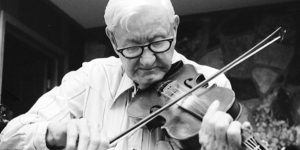
Fiddle

Fiddle built by Audrey Hash Ham Photo by Cedric N. Chatterley
One of the questions fiddlers are most often asked is, “What’s the difference between a fiddle and a violin?” The answer is that they’re actually the same instrument, but the kind of music you play determines what you call it. To classical and some jazz musicians, it’s a violin; to traditional musicians, it’s a fiddle.
A European instrument, the violin was popular in the areas where many early Appalachian settlers or their forebears came from—particularly the British Isles and Germany. It was also a natural choice for people on the move, like the early settlers. It’s an awful lot easier to carry a violin than, say, a piano; and, because it produces both melody and, through bowing technique, a strong rhythmic punch, a lone fiddler can supply all the music needed to power a community dance.
Like so many American art forms, fiddling represents a marriage of European and African influences. American fiddling often features highly syncopated bowing, a rhythmic element that points to strong African American influence. (Nowhere is this more evident than around Mount Airy, where many of the great old-time fiddlers are masters of intricate, propulsive syncopation.)
North Carolina mountain fiddlers
The North Carolina mountains and foothills have been home to great fiddlers for centuries. In old-time music, North Carolinians are numbered among the legends.
- Tommy Jarrell (1901–1985), from the community of Toast, near Mount Airy, was perhaps the most
 influential old-time fiddler of his generation, and was among the first artists honored when the National Endowment for the Arts inaugurated the National Heritage Fellowship in 1982.
influential old-time fiddler of his generation, and was among the first artists honored when the National Endowment for the Arts inaugurated the National Heritage Fellowship in 1982. - Samantha Bumgarner (1878–1960), from Dillsboro, was one of the first women recording artists in country music, when she and her friend Eva Davis first recorded in 1924.
- Marcus Martin (1881–1974), born in Macon County, recorded by the Library of Congress and several folklorists, is remembered for his beautiful and unusual tunes including “Lady Hamilton” and “Jenny Run Away in the Mud in the Night.”
North Carolina has its share of bluegrass fiddle legends too, including three influential veterans of Bill Monroe’s Blue Grass Boys.
- Art Wooten (1906–1986), from Sparta, was the first fiddler for the Blue
 Grass Boys, and was with the band when they played on the Grand Ole Opry for the first time.
Grass Boys, and was with the band when they played on the Grand Ole Opry for the first time. - Jim Shumate (1921-2013), who was born in Wilkes County and later lived in Hickory, went from fiddling with the Blue Grass Boys to joining Lester Flatt and Earl Scruggs’ Foggy Mountain Boys, appearing on their first recording session.
- Bobby Hicks, who was born in Newton, NC and now lives in Madison County, has won 10 Grammy awards during a storied bluegrass career that has spanned more than 60 years.
Fiddlers’ conventions
There are also many long-running fiddlers’ conventions in the North Carolina mountains, where fiddlers—and other musicians—gather to play with old and new friends and compete for prestigious titles.
- The Mount Airy Bluegrass and Old Time Fiddlers’ Convention began in 1972. Held yearly the weekend after Memorial Day, it’s still one of the most important dates on bluegrass and old-time fiddlers’ calendars every year.
- On the third weekend in July every year, the town of Sparta fills up with musicians gathered for the Alleghany County Fiddlers’ Convention.
- One of the newest festivals in the area, the Happy Valley Fiddlers Convention takes place on Labor Day weekend on the historic Jones Farm near Lenoir.





